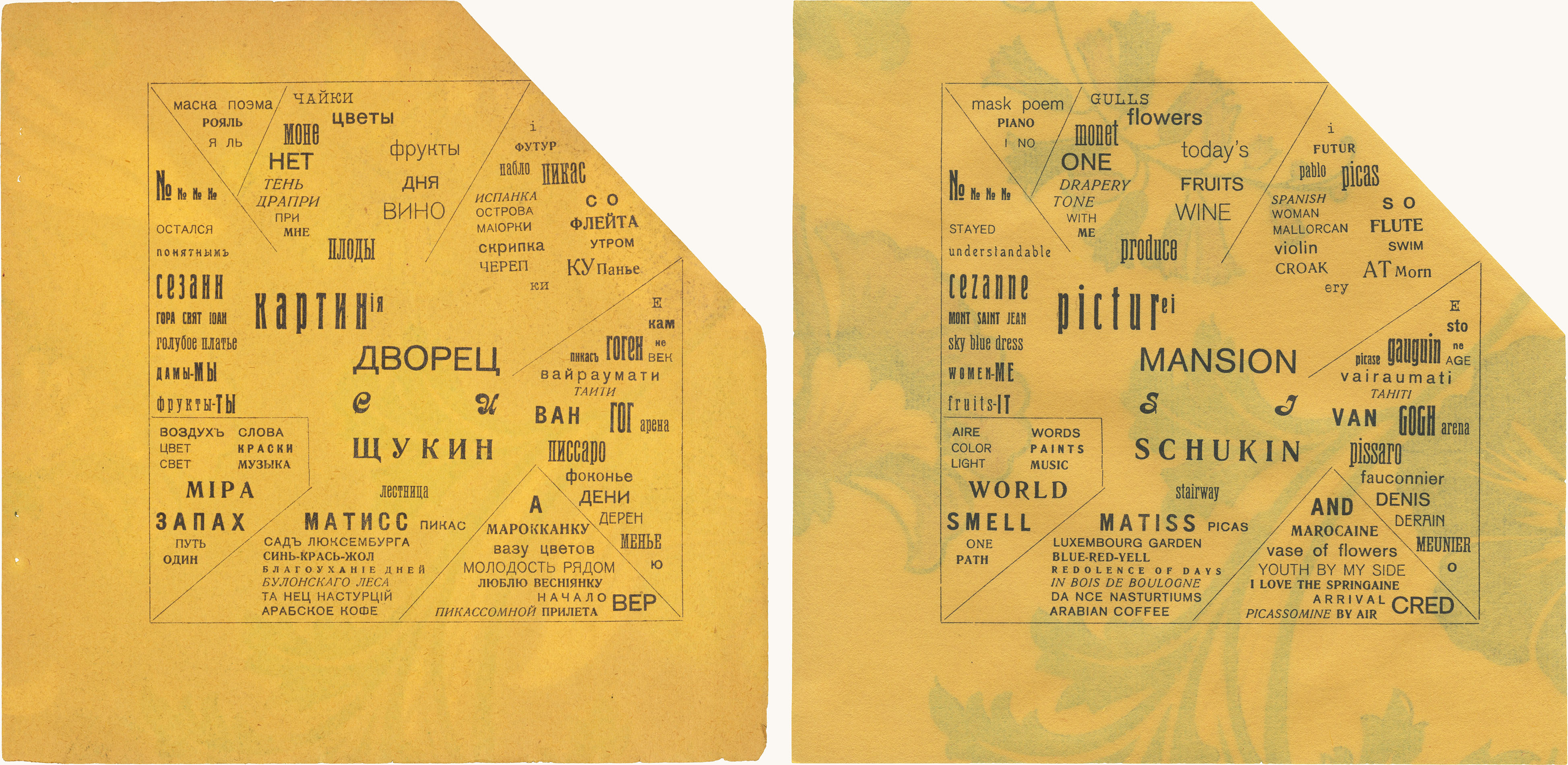Tango with Cows: Translation, Facsimile, and Commentary—a collaboration between Daniel Mellis and Eugene Ostashevsky and published by Editions 42°—is an attempt to give the English speaker access to not only the language of the original, but also its typography, design, and materiality. Every detail has been analyzed and recreated as closely as possible, from the color and texture of the wallpaper to the slight imperfections of its printed letterforms. A facsimile of the original held by the Getty Research Institute and an extensive commentary volume with a portfolio of facsimiles completes the edition.

The text has been superbly translated by Ostashevsky, an award-winning translator of the Russian avant-garde. The translation skillfully renders Kamensky’s Russian Futurist wordplay while working within the typographic constraints of the original. Its typography was recreated in English using Latin versions of the original Cyrillic typefaces. It was printed by letterpress to shed the monotonous perfection and uniformity of digital output and thereby to contain all of the subtle variations of texture and appearance of the original printing process. The wallpaper was also carefully remade using five-color screen-printing on custom-made Japanese paper, and the binding replicated. The facsimile was also bound as was the original.



The commentary contextualizes the typography, culture, and poetics of Tango with Cows with two essays by Ostashevsky, one by Mellis, a foreword by noted scholar Johanna Drucker, and five appendices. It is lavishly illustrated with well over 350 color images, seven tipped-on overlays, a double gatefold, and a miniature volvelle.
The first of Ostashevsky’s essays is a biography of Kamensky that situates his life within Russian Futurism, early aviation, and the visit of F. T. Marinetti to Russia in early 1914. The second is a detailed analysis of the poems which not only discusses the language of the original in a greater depth than can be achieved in a translation, but also details the cultural sources for Kamensky’s compositions, relating them to Moscow night life of the winter 1913–14 season.
The essay by Mellis analyzes the typography, design, and materiality of the book within the contexts of Russian Futurism, late-Imperial Russian print culture, the typographic avant-garde of prewar Europe, and the affordances of letterpress printing.
The appendices contain never-before published information about Kamensky’s plane crash in Poland, detailed reports on both the printer of Tango with Cows and its typefaces, a census of all known copies, with images of twenty-two, and a short essay on the three illustrations by David and Vladimir Burliuk.
The additional portfolio contains reproductions that could not fit in the commentary book: a facsimile of the rarely seen 1897 printing of Un coup de dés jamais n’abolira le hasard by Stéphane Mallarmé, reduced facsimiles of La Prose du Transsibérien by Blaise Cendrars and Sonia Delaunay, a poster for the Russian Futurists’ performance in February 1914 in Kazan, and a Russian circus poster, as well as a full-scale recreation of the wallpaper on which Tango with Cows was printed.

A small deluxe edition of twenty-six copies presents the reader with the most faithful facsimiles possible of Tango with Cows, La Prose du Transsibérien, and the Kazan poster for the Russian Futurist performance. Each one has been trimmed by hand to remove the distraction of a white border while preserving their slightly irregular outlines. La Prose du Transsibérien and the Kazan poster, along with a digitally restored version, have been reproduced at actual size on an archival inkjet printer for maximum color fidelity. Seven full sheets—over sixteen square feet—of the recreated wallpaper pattern, reproduced with same paper and five-color screen-printing as the translation, are included. The commentary book is hard-bound and hand-sewn with colored thread that matches the colors of the printed wallpaper. The entire production is housed in an oversized clamshell box covered in custom-woven fabric with the design of the wallpaper rendered in an elegant grayscale.
